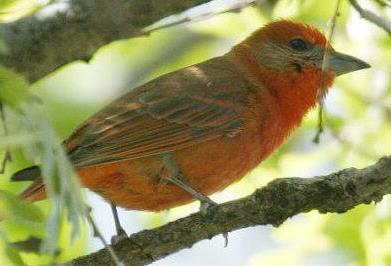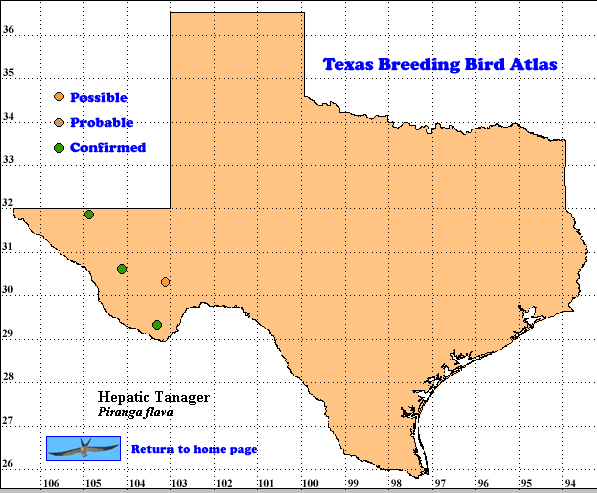The Hepatic Tanager is a broad-ranging taxon which genetic studies, plumage and habitat preferences suggest includes 3 separate species: Hepatic Tanager (Piranga hepatica) ranging from the United States to Nicaragua, Tooth-billed Tanager (P. lutea) of forest edges in foothills and mountains from Costa Rica to northern and western South America, and Red Tanager (P. flava) of open woodlands of eastern and southeastern South America (Eddleman 2002).
Hepatic Tanager males in Texas are most frequently confused with male Summer Tanagers (P. rubra), but these are brighter rosy-red and lack gray on the sides of the face. Flame-colored Tanagers (P. bidentata), accidental in Texas (Lockwood and Freeman 2004) and regular in small numbers in southeast Arizona, are generally similar to Hepatic Tanagers, but have white wing-bars, streaked backs and bold white spots on the tips of the tertials. In female Hepatic Tanagers the male’s brick-red color is replaced by olive-yellow or orange-yellow (Pyle 1997, Eddleman 2002).
DISTRIBUTION. During the 1987-1992 TBBA field work, volunteers found Hepatic Tanager breeding in the Chisos, Davis and Guadalupe mountains of Trans-Pecos Texas. These are the same three ranges where Oberholser (1974) reported the species as having bred in the past.
In other parts of the United States the species breeds in a few mountain ranges in southeastern California, across most of the higher elevations of Arizona and New Mexico and sparsely in southeast Colorado. Breeding populations in the United States and north Mexico migrate to central Mexico in winter (Eddleman 2002).
SEASONAL OCCURRENCE. Hepatic Tanagers arrive in Texas around mid-April to breed from early May to late August. Southward migration occurs around mid-October. Most migrants are found at high elevations in the Trans Pecos region (Oberholser 1974. Lockwood and Freeman 2004).
BREEDING HABITAT. Hepatic Tanagers in Texas breed between 1500 and 2400 m (5000 to 8000 ft) above sea level, in dry juniper-pinyon or pine-oak woodlands. The nest is placed in a horizontal fork, away from the trunk and hidden in foliage. The nest height ranges from 5.5-15 m (18-50 ft) above the ground. It is a loosely constructed, flat saucer built of rootlets, grasses and dry plant stems, lined with finer grasses.
The female lays 4 (range 3-5) bluish or blue-green eggs, usually less heavily marked than eggs of Western (P. ludoviciana) or Summer (P. rubra) tanagers. The incubation and nestling period lengths are unknown. A very few nests have been found with Bronzed Cowbird (Molothrus aeneus) eggs present in Mexico. Eggs of Brown-headed Cowbird (M. ater), the expected parasite in the United States, have not been found in Hepatic Tanager nests (Oberholser 1974, Harrison 1979, Eddleman 2002).
STATUS. Lockwood and Freeman (2004) characterize Hepatic Tanager as uncommon to locally common in the Guadalupe, Davis and Chisos mountains of the Trans Pecos region of Texas. In contrast Oberholser (1974) felt the status of this species as a breeder in Texas was precarious in the 1960s and early 1970s; note this time period was toward the end of the southwest dry phase of a more than 30-year Pacific Decadal Oscillation (PDO). The TBBA fieldwork in 1988-1992 took place in the midst of a PDO wet phase and atlasers found Hepatic Tanagers breeding in all three mountain ranges. The shift to another PDO dry phase in the mid-1990s however, is a worrisome factor for this species.
Hepatic Tanager in contrast to some other Trans-Pecos mountain breeding birds, is recorded on the North American Breeding Bird Survey (BBS) and is found on 3 routes at an average of <1 bird per route. Because the amount of data obtained is small, no meaningful trend data for the species is available. The trend data from all of the 32 BBS routes reporting Hepatic Tanagers in the United States is not much more helpful in defining any population change for this species (Sauer et al. 2004). Since Hepatic Tanager is only present in Texas during the breeding season and only in the Trans Pecos mountains, its status as a member of the Texas avifauna remains precarious. Continued long dry periods, as Oberholser (1974) noted, are difficult for this species in Texas. Text by Robert C. Tweit (2004)
Literature cited:
Eddleman, W. R. 2002. Hepatic Tanager (Piranga flava). In The birds of North America, No. 655 (A. Poole and F. Gill, eds.). The Birds of North America, Inc., Philadelphia, PA.
Harrison, H. H. 1979. A field guide to western birds’ nests. Houghton Mifflin, Boston, MA.
Lockwood, M. W. and B. Freeman. 2004. The TOS handbook of Texas birds. Texas A&M University Press, College Station.
Oberholser, H. C. 1974. The bird life of Texas. University of Texas Press, Austin.
Pyle, P. 1997. Identification guide to North American birds, part 1. Slate Creek Press, Bolinas, CA.
Sauer, J. R., J. E. Hines, and J. Fallon. 2004. The North American Breeding Bird Survey, results and analysis 1966-2003. Version 2004.1. USGS Patuxent Wildlife Research Center, Laurel MD (Web site, http://www.mbr-pwrc.usgs.gov/bbs).

